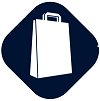Business model
Stores
|
These lie at the very heart of Inditex's business model and combine customer demands with the proposals put forward by the design teams of each different brand. They are strategically located on the most important high streets to be found in all five continents and, thanks to the meticulously designed shop windows, the exceptional architectural design to be found both inside and out, the precise coordination of the products and top-class customer care, they play an essential role in representing the image of our brands. In addition, Inditex’s concern for eco-efficiency, the focal point around which all new openings and reforms revolve, should not be overlooked. The on-line stores remain central to the Inditex Group's business model where customer care is considered of key importance. 6,009 stores in 86 countries More than 1,300 eco-efficient stores 22 countries with on-line sales |
|---|---|
Design
|
More than 1,000 professionals are in charge of product design and development and specific teams are used by each different brand. Their task is to respond to the wishes of the customers as quickly as possible using the information gathered in the stores themselves as well as on-line. More than 30,000 different models are created by the Group's design teams each season, combining the latest trends in fashion with our commitment to sustainability. In 2012, Inditex commercialized more than 4.2 million garments made with organic cotton, more than twice the amount of the previous year |
Manufacturing
|
Over 50% of Inditex's manufacturing is carried out by local suppliers. Inditex maintains stable relations with its suppliers adopting an ethical and responsible approach in keeping with the Code of Conduct for Manufacturers and Suppliers, which was updated in 2012. Anyone wishing to work with the company must first agree to adhere to said Code. During the financial year, Inditex had a total of 1,434 suppliers. More than 1.4 million chemical analyses of products 3,513 audits |
Distribution |
The logistics system, created to ensure the items on offer in the stores could be continually replaced, guarantees that the product will reach its destination in no more than two days (24-36 hours in the case of Europe and 48 hours for the rest of the world). One of the objectives is to reduce the level of emissions caused by this logistical activity by 20% by 2020. The Environmental Management System followed in seven of the eight logistical centres owned by Inditex, all of which are located in Spain, has been awarded the ISO 14001 certification. One of the objectives is to reduce the emissions from logistical activity by 20% by 2020 |



